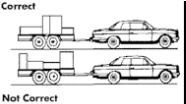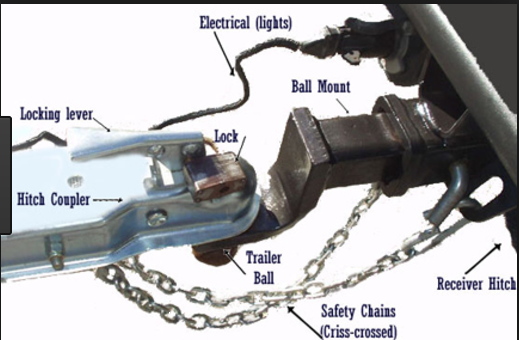Under Construction 
Tips:
- Weight Distribution:
The tongue weight on the vehicle's hitch as a percent of the total (fully loaded) trailer weight.
10-15% for large trailers
6-10% for small trailers
15-20% for fifth-wheelers
These specifications should never be exceeded and can lead to dangerously unstable driving conditions along with excessive wear and tear on your vehicle.
- Move heavier items to the front of the trailer to avoid sway.
 
Note: If too much weight is taken off the hitch with weight in the back of the trailer, the rear wheels of the towing vehicle may loose traction and skid during braking or cornering.
- Cross the safety chains under the trailer tongue to prevent the tongue from dropping onto the ground in case it should disconnect from the ball.

- Speed: Maximum speed is 55 or 60 MPH. See your trailer manual and state vehicle codes. e.g. Calif., Others
- Following distance: Allow double the amount of space between you and the vehicle in front of you when towing a trailer.
- Braking: Remember the extra weight will increase your stopping distance.
- Curves: Avoid applying brakes when going around a curve; The trailer can push the back of your vehicle out and cause a jackknife.
Instead break before the curve and accelerate in the curve so you pull the trailer thru the curve rather than it pushing you.
- Turns: Take wider turns to avoid hitting the curb.
- Hills: Use lower gears for climbing and descending grades to avoid unnecessary transmission shifting and overheating brakes.
- Sway: At the first signs of trailer sway, slow down by taking your foot off the accelerator. Let vehicle speed decrease but do not put your foot on the brake pedal, which can make the situation worse. Keep the steering wheel steady; Don't try to steer out of a sway.
Once you're down to a safe speed, carefully apply the brakes and drive slower. If the trailer contues to sway, stop and adjust your load.
Sway may also be caused by wind or gusts from passing traffic if you have a trailer with a large surface area e.g. a travel trailer.
In this case there are sway control devices you can add to your hitch.
- Occasionally lubricate terminals of the four-pin connector using terminal grease.
- If you are going up long hills (5 miles or more) in hot weather (> 104°) you should cut your trailer weight in half to avoid engine damage..
See tips at: ETrailer.com
U-Haul: Moving tips: Trailer and towing
U-Haul: Tips: Trailer-User-Instructions
edmunds.com/ownership/howto/articles/
Driving skills | govt.nz
trailers-r-less.com/trailer-towing-safety.html
Understanding Trailer Weight Safety Issues
Brakes:
Larger trailers require brakes.
The Subaru Crosstrek guidelines limit you to 1,000 lbs Gross Trailer Weight (GTW) without brakes;
You can have 1,500 lbs with brakes.
There are 2 kinds of brakes:
Hydraulic Surge Brakes:
Surge Brakes are hydraulic and use the trailer’s natural momentum to actuate the brakes. When you step on the brake in your tow vehicle and slow down, the trailer pushes against the hitch and presses a hydraulic cylinder.
Electric Brakes:
Electric Brakes provide additional ease of use and additional braking control. Electric brakes are more simple than surge brakes, but they require a brake controller in the cabin of the tow vehicle.
Most trucks, vans, SUVs and RVs made since the mid-1990s are set up to use an electronic trailer brake controller. These vehicles include a factory-installed “quick plug” under the dash that connects with a standard brake controller.
They require a larger electrical connector to the trailer.
You don't get brakes with u-Haul trailer until you get to the dual axel 5x10 cargo trailer with a load of 1.550 and GTW of 2,800 lbs.
State requirements for trailer brakes:
See Trailer Brakes - AAA Digest of Motor Laws
California:
Trailers and semitrailers built after 1966 and with a GVW of 3,000 lbs. or more must have brakes on at least 2 wheels.
New Jersey:
Brakes are required on all wheels for all trailers or semitrailers with a gross weight over 3,000 pounds; provided. The gross weight of any such trailer without brakes shall not exceed 40% of the gross weight of the towing vehicle.
North Carolina:
Every semitrailer, trailer, or separate vehicle attached by a drawbar or coupling to a towing vehicle of at least 4,000 lbs., and every house trailer weighing at least 1,000 lbs., shall be equipped with brakes controlled or operated by the driver of the towing vehicle.
Towing with a CVT:
Anxious Thoughts: The Technical Side of the Continuously Variable Transmission(CVT)
Subaru Outback Questions - Towing with Outback Limited 2.5i, 4 cylinder - CarGurus
Speed Limits when towing:
State Towing Speeds and State Laws | DoItYourselfRV.com
States for my NJ to CA trip
NJ 55
PA 55
OH 65
IN 65
IL 55
NE 65
WY 60
IO 65
NE 65
UT 65
NV 65
CA 55
Links:
Trailer Hitches
Return to auto
last updated 14 Oct 2008
|
